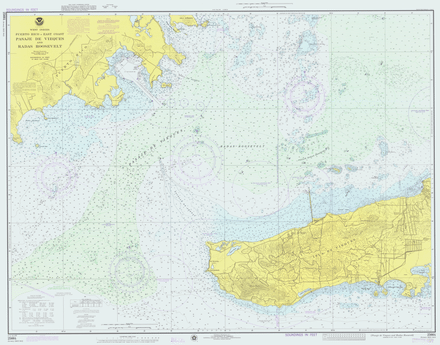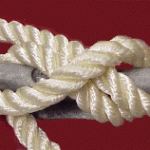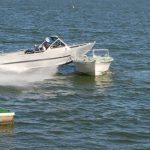Here are just a few helpful nautical and metric equivalents. There are sometimes inconsistencies between sources on many of the measurements and values, so I’ll be quick to disclaim any responsibility if you use them and get yourself into a jam.
If you’d like to add any as a useful resource and reference for yourself or others, drop me an email.
Mike O. sent me this really good email, which I want to share with you:
“Commander Bob, one thing that is important about conversion factors is developing intuition… such as, for any temperature you want to experience, convert C to F by simply doubling it and add 30. That’s within 1 or 2 degrees F. which is close enough for most applications.”
“Likewise, liters and quarts are interchangeble to any precision outside a lab or not involving 100’s of gallons.”
(Thanks for your contribution, Mike. Shortcuts help make it an easier job.)
Isolines are lines on maps or charts to represent points of equal value. Here is a list of most of the isoline terms. You’ll see some on nautical charts, and others are more obscure. Don’t try and commit all of them to memory, but perhaps knowing which ones pertain to the forecasting of weather would be important enough to remember. The others are just for fun.
Isobar…a line representing points of equal atmospheric pressure
Isobath…a line representing points of equal underwater depth
Isobathytherm…a line representing depths of water that have equal temperature
Isochasm…a line representing points of equal recurrence of auroras
Isocheim…a line representing points of equal mean winter temperature
Isochrone…a line representing points of equal time-distance from a point
Isodose…a line representing points of equal radiation intensity
Isodrosotherm…a line representing points of equal dew point
Isogeotherm…a line representing points of equal mean temperature
Isogloss…a line representing points of equal linguistic features
Isogonal…a line representing points of equal magnetic declination or variation
Isohaline…a line representing points of equal salinity in the ocean
Isohel…a line representing points of equal amounts of sunshine
Isohume…a line representing points of equal humidity
Isohyet…a line representing points of equal precipitation
Isoneph…a line representing points of equal amounts of cloud cover
Isopectic…a line representing points of equal ice formation at the same time each fall and winter
Isoplat…a line representing points of equal acidity, as in precipitation
Isopor…a line representing points of equal annual change in magnetic declination
Isostere…a line representing points of equal atmospheric density
Isotac…a line representing points of equal ice melting at the same time each spring
Isotach…a line representing points of equal wind speed
Isothere…a line representing points of equal mean summer temperature
Isotherm…a line representing points of equal temperature
Isorelief…a line representing the point where I’m finally done typing information about “isolines”!
32 points of a compass = 360 degrees
Point of a compass = 11.25 degrees
To convert degrees C. to degrees F., multiply by 9, divide by 5 and add 32
To convert degrees F. to degrees C., deduct 32, multiply by 5 and divide by 9
Inch = 2.54 centimeters
Foot (U.S.) = .3048 meters = 1 British foot
Kilometer = 3,280.8399 feet = .5399568 nm
Statute mile = 5,280 ft = 1.609 km = .869 nm
Nautical mile = 1.15 stat miles = 1,852 m = 6,076.12 ft = about 2,000 yds (generally accepted as 1 minute of latitude)
Length of 1 minute of latitude at equator = approximately 6,046 ft
Length of 1 minute of latitude at poles = approximately 6,108 ft
Knot = 1 nm/hr = 1.15 mph = 1.852 km/hr
Knot-furlong = time it takes to sail 220 yards at 1 nautical mile per hour
Fortnight = 14 days (or nights)
Furlong = 220 yards
Fathom = 6 ft = 1.829 m
Cable = 720 feet = 120 fathoms
Cable (British) = .1 nm
7.5 cables = 1 statute mile
8.44 cables = 1 nm
Charts – nautical miles per inch = reciprocal of natural scale/72,913.39
Charts – statute miles per inch = reciprocal of natural scale/63,360
Charts – inches per nm = 72,913.39 x natural scale
Charts – inches per sm = 63,360 x natural scale
Charts – natural scale = 1:72,913.39 x nm/inch
Charts – natural scale = 1:63,360 x sm/inch
Std. atmospheric pressure at sea level = 29.92126 inches of mercury
Millibar = .02952998 inches of mercury
Millimeter of mercury = 1.3332237 millibars
Register ton = 100 cubic feet
Stone = 14 pounds
Royal firkin = usually 1/4 barrel (varies based on commodity)
Measurement ton = 40 cubic feet = 1 freight ton
Barrel (42 gals) of diesel fuel = 315 pounds
Gallon of engine motor oil = 7.3 pounds
Cubic foot = 7.481 gals of water
Cubic foot of seawater = 64 lbs
Cubic foot of freshwater = 62.428 lbs @39.2 degrees F. (temp. of max. density)
Cubic foot of normal storage ice = 62 lbs
Cubit = the length of the forearm from the elbow to the tip of the middle finger (usually equal to about 18 inches)
Speed of sound is approximately 1,117 feet per second
Approximate distance (nm) of a flash of light to resulting sound = elapsed time divided by 5.5
Displacement ton = 35 cubic feet of seawater = 1 long ton
1 ton of freshwater=35.84 cubic feet
(Note: some values above are based upon relationships
enumerated in Bowditch’s American Practical Navigator,
Vol. I, 1984)
And finally, just for the fun of it…
Ratio of an igloo’s circumference to its diameter = Eskimo Pi
2000 pounds of Chinese soup = Won ton
1 millionth of a mouthwash = 1 microscope
Time between slipping on a peel and smacking the pavement = 1 bananosecond
Weight an evangelist carries with God = 1 billi-gram
16.5 feet in the Twilight Zone = 1 rod serling
Half of a large intestine = 1 semicolon
1000 pains = 1 kilohurtz
Basic unit of laryngitis = 1 hoarsepower
1 million microphones = 1 megaphone
1 million bicycles = 2 megacycles
2000 mockingbirds = two kilomockingbirds
1000 milliliters of wet socks = 1 literhosen
1 millionth of a fish = 1 microfiche
100 rations = 1 C-ration
2 monograms = 1 diagram
8 nickels = 2 paradigms
2.4 statute miles of intravenous surgical tubing at Yale University Hospital = 1 I.V. League







